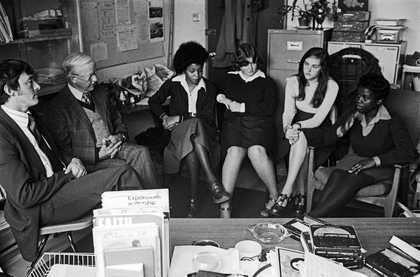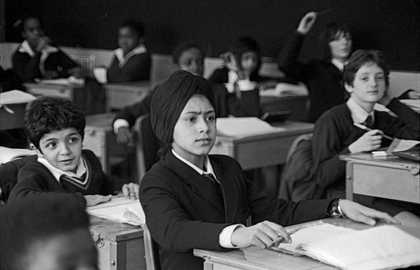An increasing interest in exploring the critical potential of video for its capability to provide live and taped feedback and the relationship between the camera, subject and spectator marked a shift in Lange’s work. In his series Work Studies in Schools 1976–7, the studies of teachers in action were extended by the videotaping of the teachers’ and pupils’ reactions to these recordings, inviting them to speak for themselves. Seen by the artist as a means of personal assessment and ‘an educational process’ – as well as a means of exposing the process of its making – Work Studies in Schools also became studies of videotaping as a work activity in itself.

Darcy Lange Study of Three Birmingham Schools (Roger Perks Students’ Responses, Ladywood Comprehensive School) 1976, photographic still. Courtesy Govett-Brewster Art Gallery and Darcy Lange Estate
Programme
Darcy Lange, Study of Three Birmingham Schools, UK 1976, ½ inch video transferred to digital, black and white, sound, approximately 12 hours (90 min selection)
This series focuses on the process of teaching and learning in the classroom in three schools contrasting social class differences: Ladywood Comprehensive and Leabank Junior, both racially-mixed state schools in low income areas, and King Edward’s Grammar, a privileged public school where pupils were accepted on academic merit. Lange considered the process of education as ‘subtly but totally political’ and ‘concerned with the establishment of values and parameters of behaviour’; its criteria of success ‘mostly orientated towards middle-class academic aspirations.’ The tapes cast teaching as a socially constructive process without assigning a value to these practices. A selection of these tapes was shown at Venice Biennale in 1976 and in Dauerleihagbe Ingrid Oppenheim at the Städtisches Kunstmuseum Bonn in 1983.
Mr Hughes, The Wheel, Lebank Junior School, 21 min
Mr Trott, English Literature Webster, King Edwards Grammar School, 10 min
Roger Perks, Animal Farm, Ladywood Comprehensive School 22 min; Perks’ response, 29 min; Perks students’ responses, 8 min
Introduced by Mercedes Vicente, series curator
Darcy Lange: Enduring Time is supported by LUMA Foundation and Govett-Brewster Art Gallery. All works in this programme courtesy Govett-Brewster Art Gallery from material preserved and made available by Ngā Taonga Sound & Vision.

